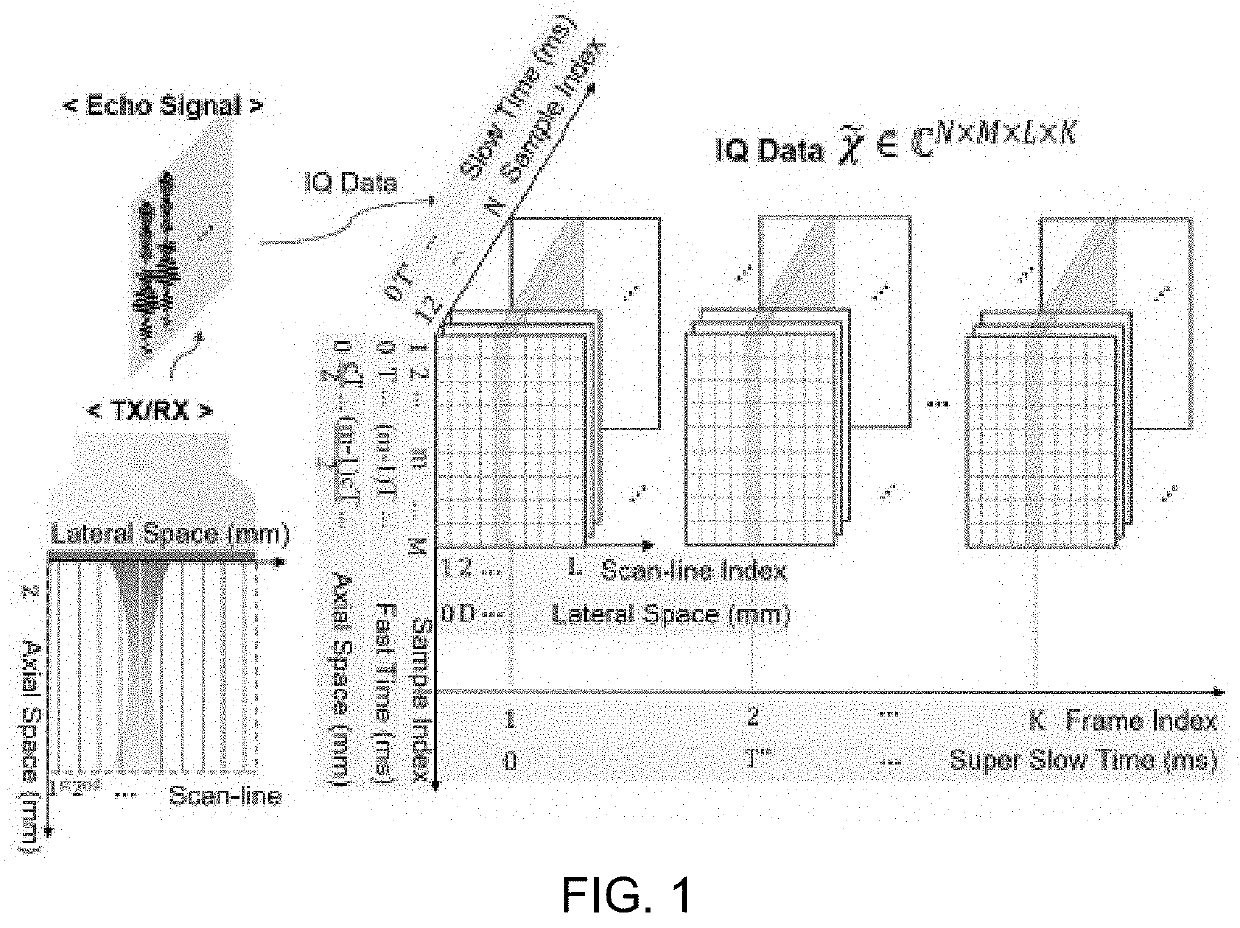Ultrasonic imaging with clutter filtering for perfusion
a technology of ultrasonic imaging and filtering, applied in ultrasonic/sonic/infrasonic image/data processing, image enhancement, instruments, etc., can solve the problems of low signal-to-noise ratio, clutter effect, loss of contrast, etc., and achieve high similarity region
- Summary
- Abstract
- Description
- Claims
- Application Information
AI Technical Summary
Benefits of technology
Problems solved by technology
Method used
Image
Examples
example 1
[0280]Echo data were recorded using a VevoR 2100 system and a MS400 linear array (FUJIFILM VisualSonics Inc. Toronto, Ontario, Canada). The transducer transmits 2-cycle pulses with a 24 MHz center frequency. All processing was implemented in Matlab 2013b on an Intel processor i5-4300U CPU, 2.50 GHz. The highest computational burden may be filter construction, which was performed using a truncation technique to minimize running time. The average time to compute the 1600 windows for one PD image frame was 19.1 s.
[0281]In Vivo Perfusion Imaging
[0282]A murine model of partial hindlimb ischemia was used to study the feasibility of our methods for in vivo perfusion imaging (FIG. 5). Each mouse was anesthetized with 1.5% isofluorane vaporized in O2 at a rate of 1 L / min via nose cone. Each animal underwent hindlimb occlusion of the right femoral artery, without disturbing non-femoral peripheral flow to the right leg or any blood flow to the left leg. Briefly, the anesthetized mouse was plac...
example 2
[0299]Simulation. Simulation data can be used to illustrate a clutter filter GM classifier embodiment of this invention. A classifier was trained and tested using simulation data and then applied in the phantom and in vivo tumor studies shown in the following. FIG. 16(a) illustrates 6 of 12 heterogeneous regions Ω from which echo data were simulated for classifier training. The size of each field was 1 mm×1 mm and vessel diameters ranged between 10 and 100 μm. The center frequency of pulse transmissions was either 10 or 15 MHz. Point scatterers were initially uniformly distributed in tissue regions Ωc and vascular regions Ωb. Tissue regions were further divided into Ωc1 and Ωc2 with different echogenicity. Displacements of all scatterers over time follow the tissue and blood motion functions described above. Included in the 12 training fields, clutter-to blood ratios were varied over the range 15 dBCBBN<30 dB via Equation (23). For training, 1800 data arrays were produced from the 1...
example 3
[0314]Results obtained at 12.5 MHz and 5.0 MHz applied the acquisition parameters listed in Table 2 and clutter filter parameters listed in Table 6. The higher pulse frequency provides greater sensitivity and spatial resolution to flow echoes but less penetration in attenuating media. A validation frequency range of 5-12.5 MHz spans most of clinical imaging. Note the number of samples in the spatial sub-block window used to develop clutter filters was adjusted so the spatial areas applied at both pulse frequencies were about the same. Similarly, the numbers of pulses per frame and the number of frames recorded were adjusted to give roughly equal numbers at 5 and 12.5 MHz.
[0315]A. Flow Speed Measurements
[0316]FIG. 26 summarizes velocity estimation experiments using Phantom I. Negative velocities indicate flow away from the transducer (opposing the direction indicated in FIG. 25).
[0317]The results indicated that spatial-average velocity r) closely tracks the independent stopwatch meas...
PUM
 Login to View More
Login to View More Abstract
Description
Claims
Application Information
 Login to View More
Login to View More - R&D
- Intellectual Property
- Life Sciences
- Materials
- Tech Scout
- Unparalleled Data Quality
- Higher Quality Content
- 60% Fewer Hallucinations
Browse by: Latest US Patents, China's latest patents, Technical Efficacy Thesaurus, Application Domain, Technology Topic, Popular Technical Reports.
© 2025 PatSnap. All rights reserved.Legal|Privacy policy|Modern Slavery Act Transparency Statement|Sitemap|About US| Contact US: help@patsnap.com



